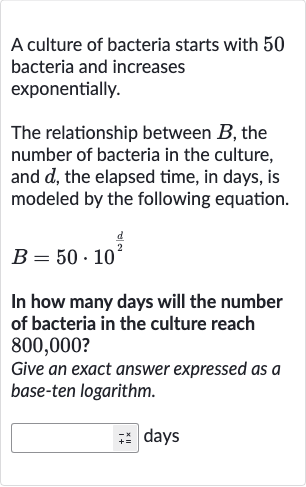AI tutor
Welcome to Bytelearn!
Let’s check out your problem:

A culture of bacteria starts with bacteria and increases exponentially.The relationship between , the number of bacteria in the culture, and , the elapsed time, in days, is modeled by the following equation.In how many days will the number of bacteria in the culture reach , ?Give an exact answer expressed as a base-ten logarithm.days
Full solution
Q. A culture of bacteria starts with bacteria and increases exponentially.The relationship between , the number of bacteria in the culture, and , the elapsed time, in days, is modeled by the following equation.In how many days will the number of bacteria in the culture reach , ?Give an exact answer expressed as a base-ten logarithm.days
- Given exponential growth model: We are given the exponential growth model for the bacteria culture:We want to find the value of when is .First, we set up the equation with :
- Set up equation: To solve for , we first divide both sides of the equation by to isolate the exponential term:
- Isolate exponential term: Perform the division on the left side of the equation:
- Take base-ten logarithm: Now, we take the base-ten logarithm of both sides to solve for :
- Simplify right side: Using the property of logarithms that , we can simplify the right side of the equation:Since is , this simplifies to:
- Multiply both sides: Now, we multiply both sides by to solve for :
- Calculate value of d: We can now calculate the value of using a calculator:
- Final answer: The exact answer expressed as a base-ten logarithm is:d = This is the final answer in the form requested.
